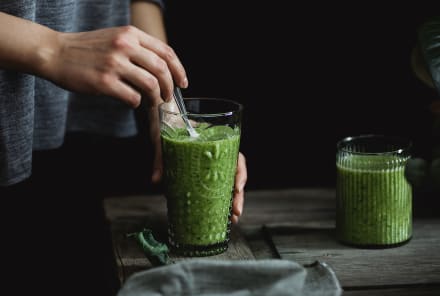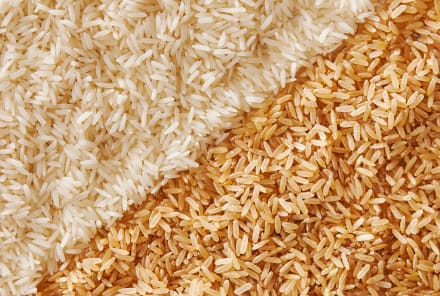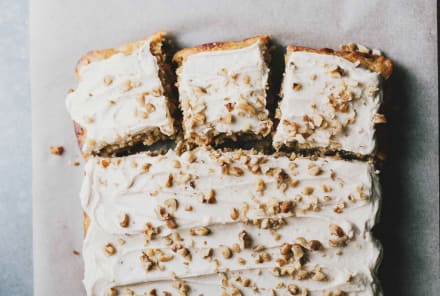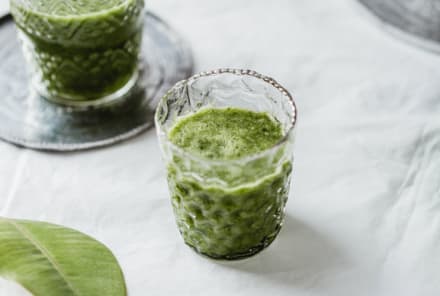Advertisement
The Key To This Vegan Pastry Is A Familiar Mediterranean Pantry Essential

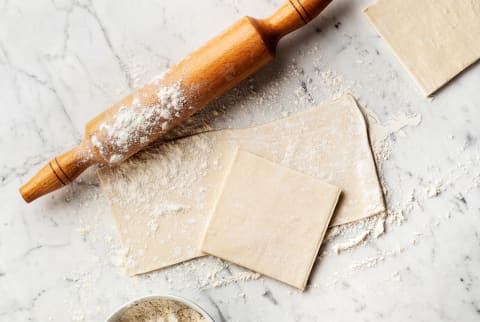
The precise practice of perfect pastry seems to hinge on the inclusion of butter, but that means that those who opt for a plant-based diet are cut out of the world of pies, tarts, and beyond—until you broaden the scope of your pastry search. So we were more than pleasantly surprised to find an all-star vegan pastry recipe in Dessert Person, the new cookbook from dessert queen Claire Saffitz. And even better, her vegan pastry option is based around a familiar Mediterranean diet pantry staple: olive oil.
"As a baker I prize all that butter, with its flake-making properties and rich flavor, brings to the table," writes Saffitz in the introduction to the recipe, "so I was surprised to learn that olive oil can, in fact, produce a tender, flaky, vegan alternative to classic pie dough."
The process isn't exactly a simple swap in of olive oil for butter in a traditional pie dough recipe: It relies on a process of rolling out the dough, brushing on the olive oil, and adding folds before rolling it out and repeating the process to create the layers that give this crust it's flaky texture.
The final product does have a bit of that signature olive oil flavor, so it's best to keep that in mind when planning to use the recipe. "Because the crust is redolent of olive oil, I think it works best in savory recipes," she says, "but for a version that pairs well with sweet, see the coconut oil variation" (which we've shared the details of below).
Coconut oil is, of course, a popular swap for butter in vegan baking, but it doesn't always work because of its strong, distinct flavor—which is why this olive oil alternative may just get a regular recurring role in our pastry rotations going forward.
Flaky Olive Oil Dough
Makes 1 9-inch pie or tart crust
Ingredients
- 1¾ cups all-purpose flour
- 1 tablespoon sugar
- 1 teaspoon Diamond Crystal kosher salt
- ¼ teaspoon baking powder
- 7 tablespoons extra-virgin olive oil
Method
- Mix the dry ingredients: In a medium bowl, whisk together the flour, sugar, salt, and baking powder to combine. Make a well in the center of the dry ingredients.
- Work in the oil: Pour 6 tablespoons of the oil into the well and use a fork to incorporate some of the flour from around the sides of the bowl until you have shaggy pieces.
- Break up the pieces with your fingertips so they're no larger than a pea.
- Bring the dough together: Drizzle ¼ cup cold tap water into the bowl, stirring constantly with a fork, then switch back to your hands and knead the mixture inside the bowl until a dough comes together. Transfer the dough to a work surface, leaving any floury bits behind in the bowl, then add more water 1 teaspoon at a time to the bowl to bring the rest of the dough together; add it to the rest of the dough.
- Knead and chill: Knead the dough a few times just until it's smooth (you don't want to work the dough too much, although the oil does help prevent gluten development, thus protecting it against toughness). Press the dough into a ½-inch-thick square, wrap it tightly in plastic, and refrigerate for 1 hour.
- Roll in more oil to create flakiness: Roll out the dough between two large sheets of parchment paper, periodically peeling off and repositioning each piece of the parchment, one at a time, for wrinkle-free rolling, to a ⅛-inch-thick square. You can skip the step of brushing the dough with more oil and rolling it up if you want to save time—the baked dough will still turn out flaky, just not as flaky.
- Use a firm hand to roll out the dough—this is not as delicate a pastry as pie dough, nor is it as prone to stickiness, since there's no butter to soften. If the dough isn't rolling out easily and stubbornly springs back, cover it and let it rest on the surface for 10 minutes before going over it again with the rolling pin.
- Remove the top sheet of parchment paper and brush the remaining 1 tablespoon oil across the surface of the dough. Starting at the side closest to you, fold up the dough into a flat, loose roll.
- Flatten the roll with the heel of your hand across the entire length. Roll out the dough into a rough rectangle that's about ¼ inch thick, then bring the left and right sides of the dough inward to fold it in thirds (this step ensures lots of flaky layers).
- Wrap the dough in plastic, pressing out any air, and press down on the dough with the heel of your hand to flatten it into a ½-inch-thick disk. Refrigerate the dough until it's relaxed, at least 30 minutes and up to 3 days. It's now ready to use.
Sweet Coconut Oil Crust
Method
- Place ⅔ cup virgin or refined coconut oil (5.3 oz./150 g) in a small bowl and refrigerate until very solid, 20 to 30 minutes. (If you like the flavor of coconut, use virgin coconut oil; for a more neutral flavor, go with refined.)
- Use the chilled coconut oil in place of the 7 tablespoons olive oil in the dough, cutting it into the flour mixture using a pastry blender or two knives (to avoid melting the oil with your fingertips) until you have pieces no larger than a pea.
- Proceed with the recipe, but note that you'll likely need a couple of additional tablespoons of ice water to bring the dough together.
- After chilling, let the cold dough sit at room temperature for 15 minutes to allow it to soften before rolling out (this dough will be more crumbly than the olive oil version).
- Brush the surface of the rolled-out dough with 1 tablespoon melted coconut oil in place of the remaining 1 tablespoon olive oil, then proceed as written above.
Watch Next
Enjoy some of our favorite clips from classes
Enjoy some of our favorite clips from classes
What Is Meditation?
Mindfulness/Spirituality | Light Watkins
Box Breathing
Mindfulness/Spirituality | Gwen Dittmar
What Breathwork Can Address
Mindfulness/Spirituality | Gwen Dittmar
The 8 Limbs of Yoga - What is Asana?
Yoga | Caley Alyssa
Two Standing Postures to Open Up Tight Hips
Yoga | Caley Alyssa
How Plants Can Optimize Athletic Performance
Nutrition | Rich Roll
What to Eat Before a Workout
Nutrition | Rich Roll
How Ayurveda Helps Us Navigate Modern Life
Nutrition | Sahara Rose
Messages About Love & Relationships
Love & Relationships | Esther Perel
Love Languages
Love & Relationships | Esther Perel

